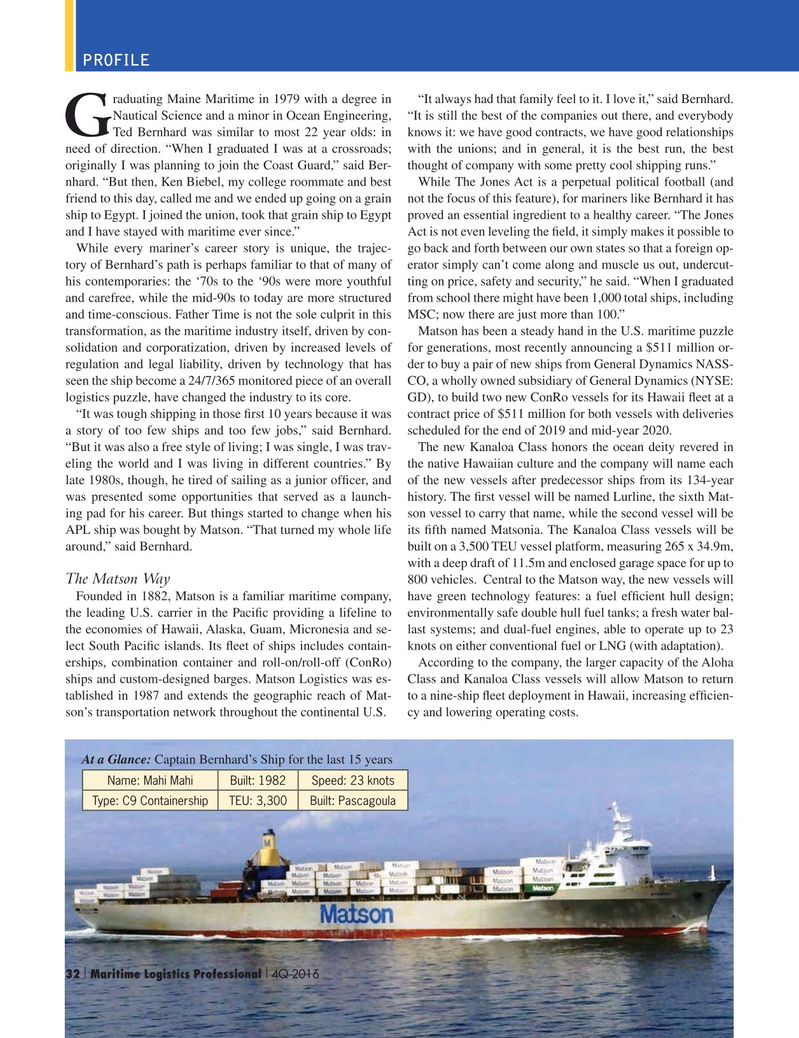
Page 32: of Maritime Logistics Professional Magazine (Q4 2016)
Workboats
Read this page in Pdf, Flash or Html5 edition of Q4 2016 Maritime Logistics Professional Magazine
PROFILE raduating Maine Maritime in 1979 with a degree in “It always had that family feel to it. I love it,” said Bernhard.
Nautical Science and a minor in Ocean Engineering, “It is still the best of the companies out there, and everybody
GTed Bernhard was similar to most 22 year olds: in knows it: we have good contracts, we have good relationships need of direction. “When I graduated I was at a crossroads; with the unions; and in general, it is the best run, the best originally I was planning to join the Coast Guard,” said Ber- thought of company with some pretty cool shipping runs.” nhard. “But then, Ken Biebel, my college roommate and best While The Jones Act is a perpetual political football (and friend to this day, called me and we ended up going on a grain not the focus of this feature), for mariners like Bernhard it has ship to Egypt. I joined the union, took that grain ship to Egypt proved an essential ingredient to a healthy career. “The Jones and I have stayed with maritime ever since.” Act is not even leveling the ? eld, it simply makes it possible to
While every mariner’s career story is unique, the trajec- go back and forth between our own states so that a foreign op- tory of Bernhard’s path is perhaps familiar to that of many of erator simply can’t come along and muscle us out, undercut- his contemporaries: the ‘70s to the ‘90s were more youthful ting on price, safety and security,” he said. “When I graduated and carefree, while the mid-90s to today are more structured from school there might have been 1,000 total ships, including and time-conscious. Father Time is not the sole culprit in this MSC; now there are just more than 100.” transformation, as the maritime industry itself, driven by con- Matson has been a steady hand in the U.S. maritime puzzle solidation and corporatization, driven by increased levels of for generations, most recently announcing a $511 million or- regulation and legal liability, driven by technology that has der to buy a pair of new ships from General Dynamics NASS- seen the ship become a 24/7/365 monitored piece of an overall CO, a wholly owned subsidiary of General Dynamics (NYSE: logistics puzzle, have changed the industry to its core. GD), to build two new ConRo vessels for its Hawaii ? eet at a “It was tough shipping in those ? rst 10 years because it was contract price of $511 million for both vessels with deliveries a story of too few ships and too few jobs,” said Bernhard. scheduled for the end of 2019 and mid-year 2020.
“But it was also a free style of living; I was single, I was trav- The new Kanaloa Class honors the ocean deity revered in eling the world and I was living in different countries.” By the native Hawaiian culture and the company will name each late 1980s, though, he tired of sailing as a junior of? cer, and of the new vessels after predecessor ships from its 134-year was presented some opportunities that served as a launch- history. The ? rst vessel will be named Lurline, the sixth Mat- ing pad for his career. But things started to change when his son vessel to carry that name, while the second vessel will be
APL ship was bought by Matson. “That turned my whole life its ? fth named Matsonia. The Kanaloa Class vessels will be around,” said Bernhard. built on a 3,500 TEU vessel platform, measuring 265 x 34.9m, with a deep draft of 11.5m and enclosed garage space for up to 800 vehicles. Central to the Matson way, the new vessels will
The Matson Way
Founded in 1882, Matson is a familiar maritime company, have green technology features: a fuel ef? cient hull design; the leading U.S. carrier in the Paci? c providing a lifeline to environmentally safe double hull fuel tanks; a fresh water bal- the economies of Hawaii, Alaska, Guam, Micronesia and se- last systems; and dual-fuel engines, able to operate up to 23 lect South Paci? c islands. Its ? eet of ships includes contain- knots on either conventional fuel or LNG (with adaptation).
erships, combination container and roll-on/roll-off (ConRo) According to the company, the larger capacity of the Aloha ships and custom-designed barges. Matson Logistics was es- Class and Kanaloa Class vessels will allow Matson to return tablished in 1987 and extends the geographic reach of Mat- to a nine-ship ? eet deployment in Hawaii, increasing ef? cien- son’s transportation network throughout the continental U.S. cy and lowering operating costs.
At a Glance: Captain Bernhard’s Ship for the last 15 years
Name: Mahi MahiBuilt: 1982Speed: 23 knots
Type: C9 ContainershipTEU: 3,300Built: Pascagoula | | 32 Maritime Logistics Professional 4Q 2016 18-33 Q4 MP2016.indd 32 11/10/2016 10:34:32 AM

 31
31

 33
33
